By Jeffrey A. Rendall, Photos By Jeff Janas
URBANA, MD -- Make sure you close the gates, or the cows might knock over the flagstick.
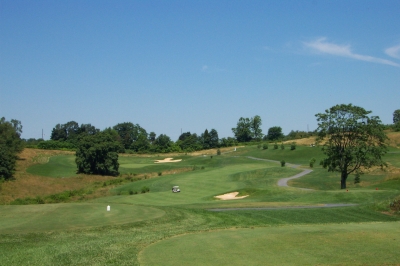 |
| Worthington Manor's 3rd hole is its toughest. It requires an accurate drive and steady nerve on the second shot to earn a well deserved par. |
We hear a lot these days about turning former farmland into golf courses. It makes sense to build a golf course on a retired farm -- after all, it's a large tract of open land, usually located apart from densely populated urban areas and allows for land purchase en masse and fewer land use restrictive hassles. But bringing golf to the country establishes its own set of problems.
Eric Ault, of Ault, Clark & Associates, worked with his father Brian to create Worthington Manor Golf Club in Urbana, Maryland. He says the property's original bovine inhabitants sometimes made things tough for the humans when they were working on the course. "When we first went out to the property and assessed it for its potential as a golf course, the one thing we had to contend with most were the cows," Ault adds.
"We'd need to be conscious of where they were at all times, or we'd leave a gate open and half of them would be out behind the cars somewhere."
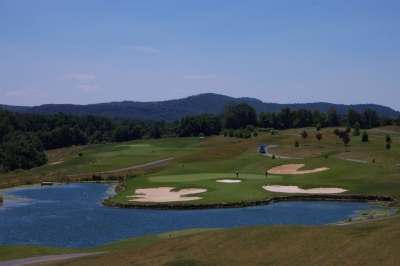 |
| The 198 yard, par three 6th hole is Worthington Manor's signature hole. Here, you can see why. |
I guess it's a small bump in the road to creating something special, which the end result definitely accomplished. Worthington Manor was the first of three courses to open within a few miles of each other in this northwest DC suburb, and all three are incredible layouts (the others are PB Dye Club and Whiskey Creek). I'd say the trio together in one relatively small area might just be the finest concentration of independent public golf courses per mile than any place north of Myrtle Beach. And it's only going to get better -- a fourth track is under construction just a few miles distant.
Tom Clark says the Worthington Manor project came together partly due to nearby Montgomery County's moratorium on new golf course development. "Montgomery County declared that it wasn't going to build any new golf courses -- and that left a big underserved golf market for the expanding population in the region. The folks in Frederick County realized the potential to attract some new business, and were open to the idea of developing some upscale golf courses."
A decade later, this once rural farming community is seeing quite a few folks trading in tractors for Titleists. The surrounding area's growing, too--with a number of new communities recently completed or just starting out a short drive away.
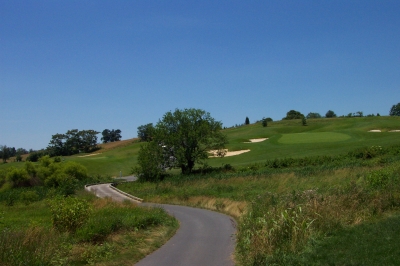 |
| As you'd expect in an Ault/Clark course, there are some terrific short par fours, including this one, the 8th hole. |
The course hardly changes the rural landscape, though. Worthington Manor is mostly wide open and blends in nicely with the surrounding farms -- you might call it peaceful coexistence. The 'Worthington' part of the name comes from the Worthington family that used to own the land, and the 'Manor' part comes from the circa 1858 mansion that sits on the property -- that now functions as the clubhouse, executive offices and the course's eating establishment.
The layout was fully operational in July of 1998, and today shows a complete maturity -- save for some growing years missing from its trees. It's fields of green separated by tall grasses, ponds and a few trees -- very much the Scottish links look to it. But no more cows -- they're safely pastured somewhere else.
Worthington Manor's quality has also attracted notice from the USGA -- the course hosted a US Open qualifier a few years back, and will hold a US Amateur qualifier at the end of July. Ed Coyle, the club's Head Golf Professional, says they don't alter the course much for the competitions: "They don't even ask us to make many changes to the course for the tournaments, like cutting down the greens or growing the rough. It's a real tribute to the way we keep playing conditions for the general public."
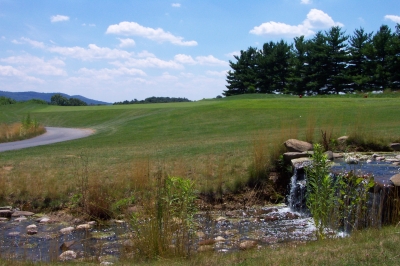 |
| No livestock sipping out of this stream, thankfully. |
He's right. The greens run very quick, and the contours offer a real challenge to the short game. The surfaces are medium sized, and you'll need to be careful about placement in the fairways to allow a good angle to attack them.
Coyle elaborates, "Since the course is pretty wide open, you'll be able to spray the ball around without losing too many balls. But the real test is in the approach shots to the greens. If you haven't set up the shots well on your tee shots, you won't be able to hold the greens."
"It's far from a target golf course, but that doesn't mean you can be careless off the tee and still score low here. If you miss on the wrong side of the green, it'll require an All-Star up and down effort to save par."
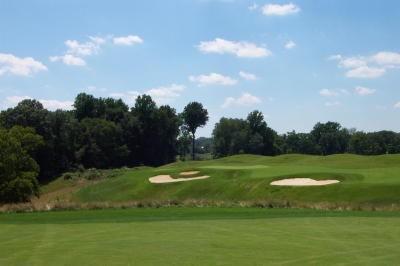 |
| The 459 yard, par four 12th is the #1 handicap hole. Try making this carry with a long iron, and you'll discover why. |
Like for most courses, a return trip or two will certainly help in knowing where--and where not--to miss. For the first time player, it can be an adventure at times -- especially since everything looks so open.
The journey begins with what the yardage book calls the 'three most difficult opening holes you'll find anywhere.' The first two are dogleg left par fours (414 and 395, respectively) and the third is a fairly straight on four par with a lengthy forced carry on the second shot.
Immediately you'll notice the need to hit fairways. Numbers one and two have tall grass all down the left side, and there are short forced carries off the tee. Missing right is no picnic either, as deep rough awaits on sloped ground on that side, too. You'd better hit some driver shots on the range to warm up, because these holes won't ease you into the round.
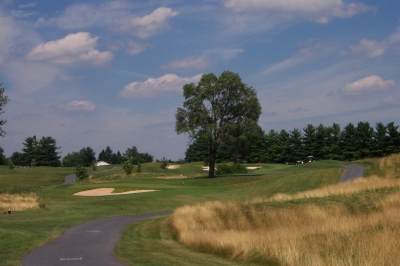 |
| The layout is nicely accented with trees and tall grass, in just the right proportions. |
Number three is Worthington Manor's #2 handicap hole, but the yardage book describes it as the toughest hole. The tee shot is downhill, with a large tree and a bunker guarding the right side of the fairway -- but if you choose the left side, you'll bring more uphill slope into the second shot. The approach shot, as Coyle alluded to, will test your nerve. It calls for a slightly uphill, full carry over wetlands to a severely sloping back to front green -- so you can't miss long or short. There is a layup option to the short right side of the wetlands, virtually guaranteeing a bogey -- but that's better than a triple.
Eric Ault says, "If you can get through the first three holes in one or two over, you'll have a chance for a good round, because it eases up after that." He's right, but then again, he designed the place -- so he should know!
Number six is the signature hole, a 198 yard par three requiring a carry over water and bunkers. The only attractive miss is center and long, but even that would be a tough par save. It's also possible to miss to the front right, but that's flirting with a pot bunker. A beautiful, challenging, memorable hole.
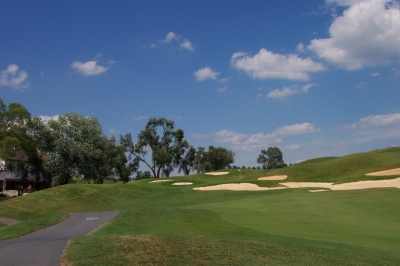 |
| If you survive the tee shot, you'll have your chances at birdie on the par five 18th hole. |
Number nine's a terrific par five to close out the front nine. Possibly reachable at 536 yards, the choice comes on the second shot -- the true measure of a great par five! The green's guarded by wetlands in front, but the second shot's shortened by its downhill nature. If your drive's long enough, it's mighty tempting to go for it -- but don't be long here either, because the putting surface slopes steeply back to front. The smart choice is a short iron layup in front of the wetlands, and a sand wedge to the green.
Back nine highlights start with number twelve. The layout's number one handicap hole, it's a 459 yard dogleg right. Here, again, the greatest challenge lies on the approach shot -- as you'll be shooting over a ravine to a green well guarded by bunkers and a steep slope to the left, and rough long. There is a bailout area to the front right, but that'll leave a tough uphill pitch to another sloping green.
Seventeen's an incredible par three. Here, you've left the wide open spaces for the trees, and you're shooting downhill to a narrow green fronted by a creek and protected by a bunker (and trees) to the left. There is a good amount of room to miss short, but the green humps slightly in the middle, so chipping's tough here.
Eighteen's a nice closing hole -- a 525 yard par five. It feels like you're firing out of a chute off the tee, as there are trees encroaching on both sides and wetlands to the front. The second shot presents two options -- a high fairway and low fairway with rough in between. Bunkers surround the green with a small run up option to the right. A good, fair, golf hole.
After playing Worthington Manor, it's easy to see why the USGA has selected the course to host some events. It's got fair challenge, aesthetic beauty, and a pleasant setting. But the best thing of all might be that the cows have moved on to greener pastures.
Details:
Worthington Manor Golf Club
8329 Fingerboard Road
Urbana, MD 22406
Phone: (301) 874-5400; 1-888-987-2582
FAX: (301) 874-2655
Website: www.worthingtonmanor.com
Course Designer: Ault, Clark & Associates
Head Golf Professional: Ed Coyle
| Tees | Yardage/Slope |
| Black | 7014/143 |
| Blue | 6502/132 |
| White | 6001/122 |
| Red | 5206/116 |
Rates:
Mon-Thurs: $60 with cart ($49 to walk). After 12:00 p.m., $50/$39. After 4:00 p.m., $35.
Fri-Sun and holidays: $75 until noon (cart mandatory). After 12:00 p.m., $60/$49. After 4:00 p.m., $40, all you can play.
Ladies day on Monday. Frederick County Day on Wednesday and a Senior Day on Thursday. All, $45.
| Related Links | Comments on this article? | |
|
Maryland National Golf Club Hollow Creek Golf Club Rocky Gap Resort PB Dye Golf Club in Ijamsville Whiskey Creek Golf Club |
E-mail Jeff Rendall, Editor: jrendall@golftheunitedstates.com |











